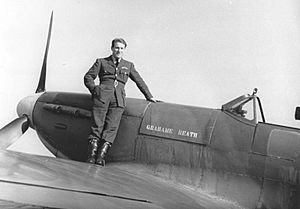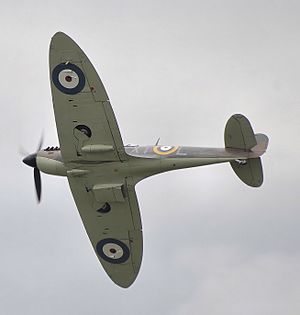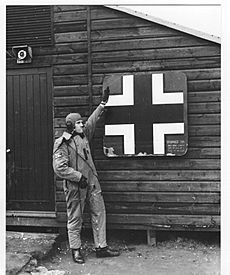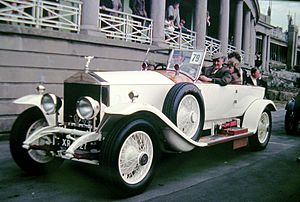Barrie Heath facts for kids
Quick facts for kids
Barrie Heath
|
|
|---|---|

Barrie Heath photographed on the wing of Spitfire IIa P7883 "Grahame Heath", which had been donated by his parents in memory of his older brother, a pilot in the Royal Flying Corps who was killed in the First World War
|
|
| Born | 11 September 1916 Kings Norton, Warwickshire, England |
| Died | 22 February 1988 (aged 71) Buckinghamshire, England |
| Allegiance | United Kingdom |
| Service/ |
Royal Air Force |
| Years of service | 1938–1946 |
| Rank | Wing commander |
| Unit | No. 611 Squadron RAF No. 43 Squadron RAF |
| Commands held | No. 324 Wing RAF |
| Battles/wars | Second World War |
| Awards | Knight Bachelor Distinguished Flying Cross Air Efficiency Award |
| Other work | Triplex Safety Glass Ltd employee (1960) Pilkington Brothers director (1967) Chairman of GKN (1975) |
Sir Barrie Heath (born September 11, 1916 – died February 22, 1988) was a brave pilot in the Royal Air Force. He flew Spitfire planes during the Second World War, especially during the famous Battle of Britain. For his courage, he received the Distinguished Flying Cross. Barrie Heath was known for shooting down enemy planes. After the war, he had a very successful career in business, eventually leading a big company called GKN. He was even made a knight for helping British businesses sell products around the world.
Contents
Growing Up: Barrie Heath's Early Life
Barrie Heath was born in Kings Norton, England, on September 11, 1916. He had an older brother named Grahame. Grahame was also a pilot, serving in the Royal Flying Corps during the First World War. Sadly, Grahame was killed in that war.
Barrie Heath's Role in World War II

Barrie Heath joined the Royal Air Force and became a pilot. In 1940, he flew with No. 611 Squadron RAF. He flew a special Spitfire plane, P7883, which was named "Grahame Heath." His father had donated money for this plane in memory of Barrie's older brother, Grahame.
Many people and towns donated money to the government during the war. This money helped pay for new planes like the Spitfire. A Spitfire cost about £5,000, which was a lot of money back then. As a thank you, the planes could be named after the donor or someone they chose. About 1,500 "presentation" Spitfires were donated during the war.
Barrie Heath was a very determined pilot. Once, his commanding officer criticized him for damaging his Spitfire during landing. Heath reportedly replied, "this is my Spit and I'll fly it any bloody way I like."
Between June 1940 and February 1941, Heath showed great skill. He shot down four enemy aircraft and damaged two others. On June 2, 1940, his Spitfire was hit by a bullet during a mission over Dunkirk.
In November 1940, he became a 'B' Flight Commander. Later, in March 1941, he became the Commanding Officer of No. 64 Squadron. He continued to rise in rank, becoming a Wing Commander in 1942. In 1944, he led the 244 Wing in Italy and later commanded the 324 Wing.
In 1944, as the war started to turn in favor of the Allies, Wing Commander Heath served with No. 43 Squadron RAF in France. This squadron was known as the "fighting cocks." Their main job was to attack enemy targets on the ground, like vehicles and railways.
On September 9, 1944, Heath led his squadron on their first mission into German territory. He was flying Spitfire IX MJ628.
After the War: A New Career
After the war ended in 1946, Barrie Heath left the RAF. He started a new career in manufacturing. He joined a company called Hobourn aero components. In 1960, he became the managing director of Triplex Safety Glass Ltd.
By 1967, he joined the board of Pilkington Brothers, a larger company. In 1975, he became the chairman of a very large industrial company called GKN. As chairman, he faced many challenges, including economic difficulties.
In 1978, Barrie Heath was made a knight by the Queen. This honor was given to him for his important work in helping British businesses sell their products to other countries. He retired from GKN in 1980.
Barrie Heath and his wife, Joan, lived in Penn, Buckinghamshire. Their son, Duncan, became a well-known talent agent.
Awards and Honors
Barrie Heath received several important awards for his service and achievements:
- Distinguished Flying Cross (DFC): On April 29, 1941, he was awarded the DFC. This award recognized his bravery and dedication while flying missions.
- Knighthood: On June 3, 1978, he was honored with a knighthood. This was for his great work in helping British companies export their goods around the world. He officially received this honor on July 12, 1978.





